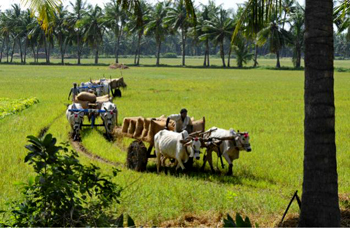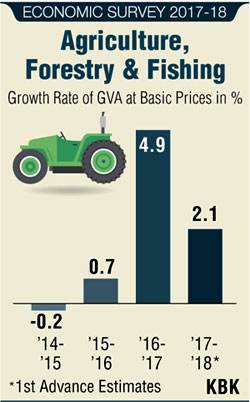BRID Fund and Operation Greens: Two Major Initiatives for Agriculture Sector in the Union Budget 2018-19
Sakshi Education
Union Finance Minister Arun Jaitley presented the Budget for the fourth time in the Lok Sabha on 1st February, 2018 with emphasis on agriculture. The major announcements by the finance minister are fixing minimum support price (MSP) of Kharif crops at least 50 per cent higher than the cost of production, raising farm credit target for the next fiscal by 10 per cent to Rs 11 lakh crore, aqua culture infra fund, animal husbandry infra fund and tax incentives to promote post-harvest agricultural activities.


The initiatives proposed for Agriculture Sector in the Union Budget 2018-19 are:
The two major announcements in the Budget:
The Union Government in its Budget 2018 has set aside Rs. 8000 crore for setting up of a dedicated Blue Revolution Infrastructure Development Fund (BRIDF).
The fund would be created in collaboration with NABARD, NCDC and Specified commercial banks. National Fisheries Development Board (NFDB) will be the Nodal Implementing Agency for overall coordination of the BRIDF activities.
BRIDF will provide concessional finance to the State Governments/Union Territories, Sate entities, cooperatives, individual entrepreneurs, etc for development of fisheries infrastructure facilities both in marine and inland fisheries sector.
Broad Areas Covered
The infrastructure facilities to be funded under the BRIDF will broadly cover –
Benefits of the Fund
The fund has the potential to benefit over 4 million marine and inland fisher folk especially women, SHGs, weaker sections, due to availability of modern infrastructure and added value of produce.
The fund would-
(i) fill the large infrastructure gaps in fisheries sector
(ii) create employment opportunity to the rural population in fishing and allied activities
(iii) contributes towards enhancement of fish production and productivity
(iv) fulfill the requirements of tapping the full fisheries potential and doubling farmers’ income.
Extend Kisan Credit Card Linked Loans
The benefit of crop loan and interest subvention so far available to agriculture sector only under Kisan Credit Card has been extended to small and marginal farmers in animal husbandry, dairying and fisheries sector for rearing of cattle, buffalo, goat, sheep, poultry and fisheries.
Operation Greens- Tomato, Onion and Potato
While agriculture itself is sensitive and vulnerable to external factors, at production and marketing stages, three universally consumed crops are relatively more sensitive. These include tomato, onion and potato. These commodities are produced in certain areas of the country and during certain seasons of the year. However, they are largely consumed across the country and all round the year. The challenge they face is connecting production and consumption centres dispersed over space, and also meet the demands that emanate over time.
Address Price Volatility
On account of inadequacy of agri-logistics that can help in storage and transportation over space and time, without compromise of quality, there are price variations which benefit neither the farmer nor the consumer. The country faces high price volatility and fluctuations in respect of these three commodities. Hence it is proposed to launch Operation Greens to address price volatility and ensure that both producers and consumers benefit.
Success of Operation Flood
Operation Flood has a lot to teach in the way it has managed a perishable commodity like mill. The success of Operation Flood lies in deployment of technology for storage, transportation and processing; professional management and institutions. On similar lines, Operation Greens shall build institutions, infuse technology and professional management to trigger productivity, processing and marketing.
The production aspects that will be taken care of by promoting protected cultivation, off-season cultivation and meet the seasonal demands. It shall also be supported by demand forecast and efficient marketing system. The Department of Agriculture, Cooperation and Farmers’ Welfare (DAF&FW) will oversee the design of the programme.
-Inputs from Union Finance Ministry, Agriculture Ministry and PIB websites
- To keep MSP for all unannounced kharif crops at least one and half times of their production cost after declaring the same for the majority of rabi cops.
- The volume of institutional credit for agriculture sector from year-to-year increased from Rs.8.5 lakh crore in 2014-15 to Rs.10 lakh crore in 2017-18 and proposed to raise this to Rs.11 lakh crore for the year 2018-19.
- The setting up a Fisheries and Aqua culture Infrastructure Development Fund (FAIDF) for fisheries sector and an Animal Husbandry Infrastructure.
- Development Fund (AHIDF) for financing infrastructure requirement of animal husbandry sector with a total corpus of Rs.10,000 crore for the two new funds.
- On the lines of ‘‘Operation Flood’’ a new Scheme ‘‘Operation Greens’’ was announced with an outlay of Rs 500 Crore to address the challenge of price volatility of perishable commodities like tomato, onion and potato.
- To develop and upgrade existing 22,000 rural haats into Gramin Agricultural Markets (GrAMs) to take care of the interests of more than 86% small and marginal farmers.
- An Agri-Market Infrastructure Fund with a corpus of Rs.2000 crore will be setup for developing and upgrading agricultural marketing infrastructure in the 22000 Grameen Agricultural Markets (GrAMs) and 585APMCs.
- So far 470 APMCs have been connected to e-NAM network and rest will be connected by March, 2018.
- Rs 200 crore for organized cultivation of highly specialized medicinal and aromatic plants
- A re-structured National Bamboo Mission with an outlay of Rs.1290 crore to promote bamboo sector in a holistic manner.
- Under Prime Minister Krishi Sinchai Yojna-Har Khet ko Pani, 96 deprived irrigation districts will be taken up with an allocation of Rs 2600 crore.
The two major announcements in the Budget:

The Union Government in its Budget 2018 has set aside Rs. 8000 crore for setting up of a dedicated Blue Revolution Infrastructure Development Fund (BRIDF).
The fund would be created in collaboration with NABARD, NCDC and Specified commercial banks. National Fisheries Development Board (NFDB) will be the Nodal Implementing Agency for overall coordination of the BRIDF activities.
BRIDF will provide concessional finance to the State Governments/Union Territories, Sate entities, cooperatives, individual entrepreneurs, etc for development of fisheries infrastructure facilities both in marine and inland fisheries sector.
Broad Areas Covered
The infrastructure facilities to be funded under the BRIDF will broadly cover –
- development of fishing harbours and fish landing centres
- creation of cold chain infrastructure facilities such as ice plants cold storage
- fish transport facilities
- fish processing units, fish markets; fish seed farms, fish feed mills/plants cage culture in reservoirs, mariculture activities, introduction of deep sea fishing vessels
- setting up of disease diagnostic and aquatic quarantine facilities etc.
Benefits of the Fund
The fund has the potential to benefit over 4 million marine and inland fisher folk especially women, SHGs, weaker sections, due to availability of modern infrastructure and added value of produce.
The fund would-
(i) fill the large infrastructure gaps in fisheries sector
(ii) create employment opportunity to the rural population in fishing and allied activities
(iii) contributes towards enhancement of fish production and productivity
(iv) fulfill the requirements of tapping the full fisheries potential and doubling farmers’ income.
Extend Kisan Credit Card Linked Loans
The benefit of crop loan and interest subvention so far available to agriculture sector only under Kisan Credit Card has been extended to small and marginal farmers in animal husbandry, dairying and fisheries sector for rearing of cattle, buffalo, goat, sheep, poultry and fisheries.
Operation Greens- Tomato, Onion and Potato
While agriculture itself is sensitive and vulnerable to external factors, at production and marketing stages, three universally consumed crops are relatively more sensitive. These include tomato, onion and potato. These commodities are produced in certain areas of the country and during certain seasons of the year. However, they are largely consumed across the country and all round the year. The challenge they face is connecting production and consumption centres dispersed over space, and also meet the demands that emanate over time.
Address Price Volatility
On account of inadequacy of agri-logistics that can help in storage and transportation over space and time, without compromise of quality, there are price variations which benefit neither the farmer nor the consumer. The country faces high price volatility and fluctuations in respect of these three commodities. Hence it is proposed to launch Operation Greens to address price volatility and ensure that both producers and consumers benefit.
Success of Operation Flood
Operation Flood has a lot to teach in the way it has managed a perishable commodity like mill. The success of Operation Flood lies in deployment of technology for storage, transportation and processing; professional management and institutions. On similar lines, Operation Greens shall build institutions, infuse technology and professional management to trigger productivity, processing and marketing.
The production aspects that will be taken care of by promoting protected cultivation, off-season cultivation and meet the seasonal demands. It shall also be supported by demand forecast and efficient marketing system. The Department of Agriculture, Cooperation and Farmers’ Welfare (DAF&FW) will oversee the design of the programme.
-Inputs from Union Finance Ministry, Agriculture Ministry and PIB websites
Published date : 10 Mar 2018 05:24PM













